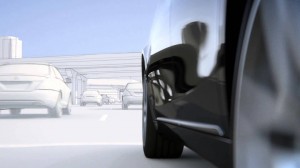 Earlier this week Nissan said company bets on creating a fully self-driven car which would only require for its passenger to lock the seat belt and enjoy the ride, by 2020. Mercedes a brand owned by Daimler is already implementing some of the technologies easing drivers parking, bumper to bumper traffic, or taking a maneuver in a tight spot.
Earlier this week Nissan said company bets on creating a fully self-driven car which would only require for its passenger to lock the seat belt and enjoy the ride, by 2020. Mercedes a brand owned by Daimler is already implementing some of the technologies easing drivers parking, bumper to bumper traffic, or taking a maneuver in a tight spot.
Daimler AGs Mercedes is leading the way with an add-on called “Stop&Go Pilot” available in its top-of-the-line S-Class sedan. Backed by an array of 12 ultrasonic detectors, five cameras and six radar sensors, the 79,800-euro ($105,800) S-Class can match the speed of the car in front of it, even coming to a complete stop and steering to stay in the lane. The feature costs 2,678 euros in Germany.
“Autonomous drive won’t come as a revolution overnight,” said to Bloomberg Jochen Hermann, director of driver-assistance systems at Mercedes. “The driver needs to get used to the technology.”
Like the Mercedes stop-and-go system, other pending auto-pilot features are geared toward handling the difficulties of the daily commute. In November, BMW plans to introduce an upgraded parking-assistant option in the 5-Series that allows hands-free driving as the car turns independently into a parking space.
Volvo Cars is working on a similar parking-garage feature and will introduce an automatic brake technology that can detect obstacles in the dark in the new XC90 next year. The sport-utility vehicle can also keep the car on the road through a system that senses where the pavement ends.
BMW and Continental AG, Europe’s second-largest maker of car parts, are collaborating on technology to master more complicated situations such as toll booths, road works and driving across national borders. Continental is spending more than 100 million euros on assisted-driving efforts this year and has 1,300 engineers involved in development.
One of the biggest hurdles is legislation. To comply with existing laws, the Mercedes system only allows the car to keep control at speeds of less than 10 kilometers (6 miles) per hour. At higher speeds, the system continuously monitors the driver and makes sure she keeps her hands on the steering wheel, letting go for more than about 10 seconds triggers a red light to flash and a beep to sound.
“We don’t want the driver to believe the system can do everything, because at the end of day, the driver is still responsible,” said Mercedes’s Hermann. While the goal is to eventually have fully autonomous vehicles, the roll-out of the technology is focused on “taking pressure off the driver in situations that arent fun.”





